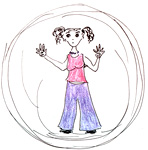
July 31, 2006
not in any way i'd like to advertise
Posted by dogpossum on July 31, 2006 8:08 PM in the category music
Every now and then there comes along a bit of music that gets inside you (to pilfer a metaphor) and makes you want to move your body.
As a DJ for dancers, I’d like that bit of music to come along more frequently. And to bring its friends. While you usually have to hunt them down, sometimes you come across these lovely things hiding in your collection, probably inside a crappy black and white CD cover for something you bought second hand. Sometimes they’re hiding in massive collected works collection on your hard drive (probably in the huge and wonderful Duke Ellington Centennial Edition: Complete RCA Victor Recordings Ellington – I promise I’ll get through the remaining ten of twenty-four discs soon).
Right now I’m just sucking up Oscar Peterson’s Bluesology At The Concertgebouw [live]. It has everything late swinging jazz should – saucy bass action, unbelievable piano, chunking guitar (that's Ray Brown and Herb Ellis, respectively), kind of growly unintelligible muttering from the Oscar at the piano… did I mention this was a live recording? You can hear the audience digging the thing these excellent musicians have going on. You can hear Oscar mumbling along to his piano (and we can assume Clark Terry’s vocals on Mumbles (check it on this album if you're interested) were inspired by this sort of action). You can just feel these seasoned musicians really working with each other, bouncing musical ideas around far beyond the ordinary length of a pop song. It goes for a massive nine minutes twenty-two – far too long for DJing to most lindy hoppers, but oh-baby, if I ever find just the right crowd…
They’d have to be a group of mellow lindy hoppers, heavy on the groove, happy to work with one partner for the equivalent of three songs (luckily at an easy 120bpm – which, for the uninitiated, is still more than two steps a second, but considered ‘baby tempo’ by lindy hoppers). And they’d better appreciate this gem…
As a DJ, as I’ve said, you’re continually on the look out for the right songs. Some DJs swap music just for the right three minutes. Morally high horse types like myself spurn this fannish exchange and have spent ridiculous sums buying a ridiculous number of albums for just that one perfect song. And while I’ve come back to those albums to rediscover the other great songs overshadowed by That One, I’ve also shoved the CD into the bookcase, or failed to catalogue the rest of it into my play lists. Lost and gone forever. itunes and emusic are your friend in these sorts of situations – I’d never buy a whole City Rhythm Orchestra album, but I’m very happy with the version of Blues in Hoss’s Flat (check that one on this album" - are you getting an idea of the sorts of uses lindy DJs make of Amazon, yet?) I bought from itunes the other day.
This version of Bluesology ends with applause for at least twenty-two seconds, until the musicians bring on the next song (When Lights are Low, incidentally, and almost as good). The very best songs for dancing are usually live – or carry some of the improvisation and creative team work that makes jazz so great for dancing. For lindy hoppers, improvisation is the reason we dance – we learn the basic steps so we can get to the made up bits. And of course, it’s so’s we can do what we hear in the music with our bodies. When it’s a live recording, you can hear the crowd and musicians really making something wonderful together. To call it a conversation is too easy or too simple. Every partner dancer knows it’s not like talking – it’s a much faster and more efficient way of communicating with someone. With lots of someones.
I think that’s the sort of thing that the best DJs aim for – recreating that relationship between musicians and dancers. As a musician, you choose the notes and how you play them to work with the other musicians and the audience and possibly the dancers to make for the nicest possible bit of group work. As a DJ, though, you’re choosing and combining songs for the same effect. The same principles of improvisation and spontaneity apply. You’re still responding and contributing to your dance partner – it’s just that you have hundreds of dance partners, and you can’t get your hands on them to get connection.
So when you find just the right song – the sort of song that makes you want to leap up off your chair – you’re not just scoring something nice to listen to or enjoy on your own. You’re finding something that’ll help you get it going on with as many people as possible. All at once.
The only frustration, the only irritation with sharing the most excellent songs with dancers is that you can’t dance yourself… well, not in any way you’d like to advertise…




